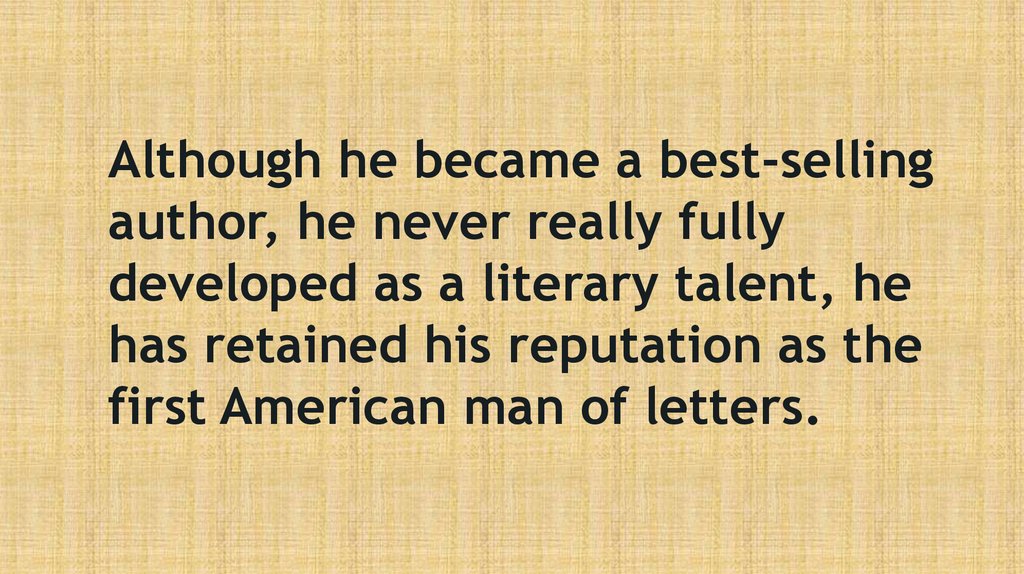Similar presentations:
Neoclassicism: Epic, Mock Epic, and Satire
1. Neoclassicism: Epic, Mock Epic, and Satire
LECTURE 3Neoclassicism:
Epic, Mock Epic, and Satire
2.
Unfortunately, "literary" writingwas not as simple and direct as
political writing.
3.
When trying to write poetry,most educated authors stumbled
into the pitfall of elegant
neoclassicism.
4.
The epic, in particular,exercised a fatal attraction.
5.
American literary patriots felt surethat the great American
Revolution naturally would find
expression in the epic.
6.
Epica long, dramatic narrative poem in
elevated language, celebrating the
feats of a legendary hero.
7.
Many writers tried but nonesucceeded.
8.
Timothy Dwight(1752- 1817)
9.
Satirical poetry fared much betterthan serious verse.
10.
The mock epic genre encouragedAmerican poets to use their
natural voices.
11.
In mock epics like John Trumbull'sgood-humored ‘M'Fingal’ (177682), stylized emotions and
conventional turns of phrase are
ammunition for good satire.
12.
The first American comedy, ‘TheContrast’(1787) by Royall Tyler,
humorously contrasts Colonel
Manly, an American officer, with
Dimple, who imitates English
fashions.
13.
Naturally, Dimple is made to lookridiculous. The play introduces the
first Yankee character.
14.
Another satirical work, the novel‘Modern Chivalry’, is published by
Hugh Henry Brackenridge. He
based his huge, picaresque novel
on Don Quixote.
15.
It describes the misadventures ofCaptain Farrago and his stupid,
brutal, yet appealingly human,
servant Teague O'Regan.
16.
The first important fiction writerswidely recognized today, Charles
Brockden Brown, Washington
Irving, and James Fenimore
Cooper, used American subjects,
historical perspectives, themes of
change, and nostalgic tones.
17.
They wrote in many prose genres,initiated new forms, and found
new ways to make a living through
literature.
18.
With them, American literaturebegan to be read and appreciated
in the United States and abroad.
19.
Charles BrockdenBrown
(1771–1810)
20.
Charles Brockden Brownwas the first professional
American writer.
21.
He was inspired by the Englishwriters.
22.
Driven by poverty, he penned fourhaunting novels in two years:
Wieland (1798),
Arthur Mervyn (1799),
Ormond (1799), and
Edgar Huntley (1799).
23.
In them, he developed the genreof American Gothic.
24.
The Gothic novel was a populargenre of the day featuring exotic
and wild settings, disturbing
psychological depth, and much
suspense.
25.
Critics suggest that Brown's Gothicsensibility expresses deep
anxieties about the inadequate
social institutions of the new
nation.
26.
Brown used distinctively Americansettings, he dramatized scientific
theories, developed a personal
theory of fiction, and championed
high literary standards despite
personal poverty.
27.
His works are darkly powerful.28.
Washington Irving(1783-1859)
29.
Washington Irving was bornon April 3, 1783 in New York
City, New York, USA.
30.
He was one of elevenchildren born to ScottishEnglish immigrant parents,
William Irving, Sr. and Sarah.
31.
He was named Washingtonafter the hero of the
American revolution (which
had just ended), George
Washington, and attended the
first presidential inauguration
of his namesake in 1789.
32.
Washington Irving waseducated privately, studied
law, and began to write
essays for periodicals.
33.
He travelled to France and Italy(1804–6), wrote whimsical
journals and letters, then
returned to New York City to
practice law -though by his own
admission, he was not a good
student.
34.
He and his brother WilliamIrving and James Kirke Paulding
wrote the ‘Salamagundi papers’
(1807–8), a collection of
humorous essays.
35.
He first became more widelyknown for his comic work, A
History of New York (1809),
written under the name of
"Diedrich Knickerbocker."
36.
In 1815 Irving went to Englandto work for his brothers'
business, and when that failed
he composed a collection of
stories and essays that became
The Sketch Book, published
under the name "Geoffrey
Crayon"
37.
In 1822 he went to theContinent, living in Germany
and France for several years,
and was then in Spain (1826)
and became attache at the US
embassy in Madrid.
38.
While in Spain he researchedfor his biography of Christopher
Columbus (1828) and his works
on Granada (1829) and the
Alhambra (1832).
39.
He was secretary of the US legationin London,later returned to Spain
as the US ambassador (1842–6), but
he spent most of the rest of his life
at his estate, near Tarrytown, NY,
turning out a succession of mainly
historical and biographical works,
including a five-volume life of
George Washington.
40.
Although he became a best-sellingauthor, he never really fully
developed as a literary talent, he
has retained his reputation as the
first American man of letters.
41.
In 1999, director Tim Burtonreleased his film Sleepy Hollow
based on Washington Irving's story
"The Legend of Sleepy Hollow."
42.
The film starred Johnny Depp aspolice constable Ichabod Crane,
who is sent from New York City to
investigate a series of murders by a
mysterious Headless Horseman.











































 literature
literature








